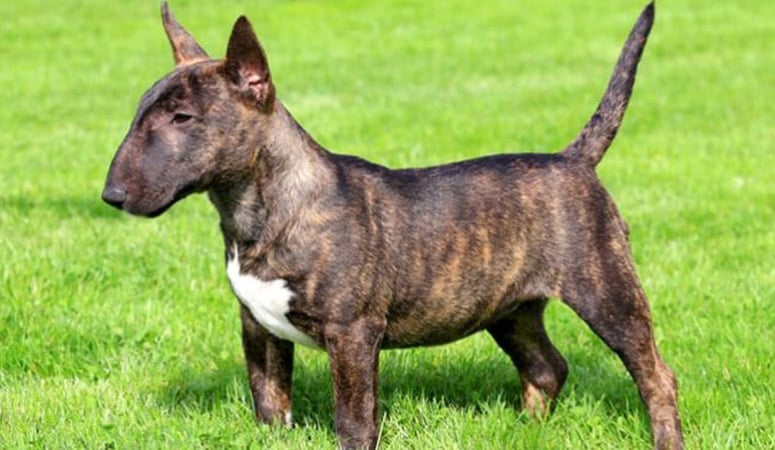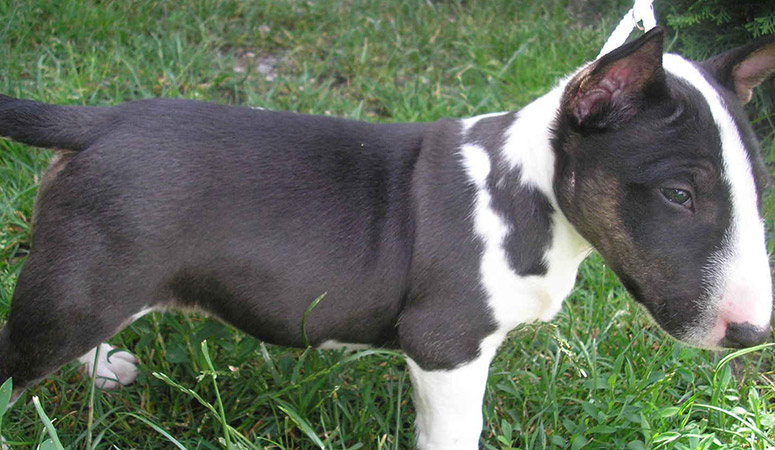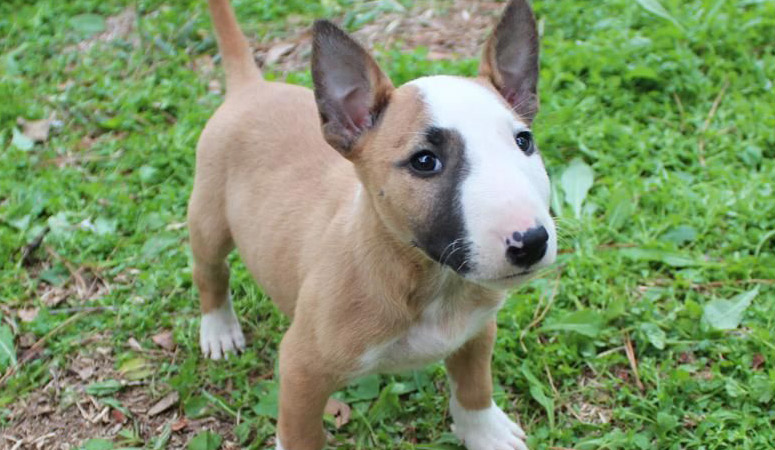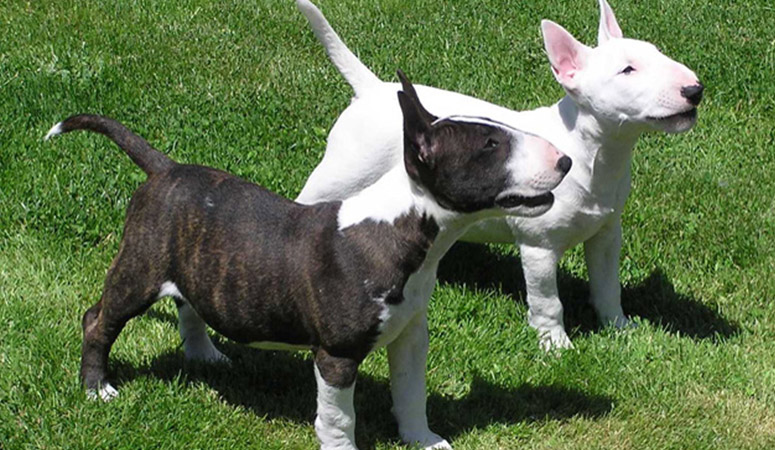Miniature Bull Terrier
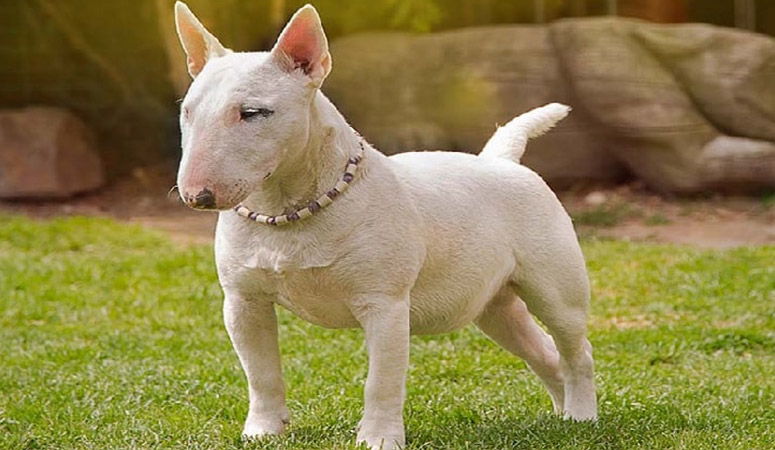
Energetic and playful, the Miniature Bull Terrier wears a keen and determined expression on its characteristic clown face and is popular among people. They have a courageous heart, although they’re small. But their stubborn nature can make the training a challenge for first-time dog owners or soft trainers. Loving Mini Bull Terriers are affectionate with family, and friendly with strangers.
| Other Names | Mini Bull Terrier, Miniature English Bull Terrier |
| Color | White, black, brindle, red, fawn and tricolour |
| Height | Males: 10-14 inches. Females: 10-14 inches. |
| Weight | Males: 25-35 pounds. Females: 25-35 pounds. |
| Life Span | 11-13 years |
| Personality | Upbeat, Mischievous, Comical |
| Exercise | Needs Lots of Activities |
| Origin |
| Popularity | #112 |
| Groom Needs | Occasional Bath/Brush |
| Kids Friendly | No |
| Dog Friendly | Yes with supervision |
| Watch Dog | |
| Family Dog | |
| Litter Size | 1 to 5 puppies |
Miniature Bull Terrier Pictures
Miniature Bull Terrier Video
Introduction
What you get with the Miniature Bull Terrier is a devoted, playful, and friendly companion – you will just love his mischievous and inquisitive nature. These spunky little dogs stand around 13 inches at the shoulders and weigh around 33 pounds. Looking at the dog, you can see he is muscular and stocky. Distinctive features of the dog are his eyes. They are triangular-shaped, small, and deep-set. He needs plenty of exercise and loves to play games. He makes a good watchdog too, even though he is not huge. He shows huge loyalty to his owners. But always remember not to leave him alone because they will become destructive then. Like bull terriers, the miniatures also have glossy, short, fine coats, so not all that much grooming is required, just a daily brush in the shedding season is adequate. The colors accepted in the ring can be white or white with another color, or fully colored. They do fine with children, but he also needs socialization from puppyhood to make him a great playmate for older kids who he will love to run and romp with. He will need a few good solid walks to keep him in shape and out of trouble.
Living with Miniature Bull Terrier
With short, glossy coat, MBT requires minimal grooming to keep his coat healthy. The Miniature Bull Terrier doesn’t require a lot of grooming beyond regular baths and a weekly once-over with a soft brush or hound glove. They do shed heavily in the spring and fall, and brushing will need to occur daily.
They don’t require frequent bathing, and many owners use a dry shampoo or damp cloth to keep the dog looking and smelling fresh in between baths.
Trimming nails with a nail clipper regularly will help avoid splitting and cracking of an overgrown nail and prevent painful splitting, cracking, or a broken nail.
Weekly tooth brushing will keep the teeth and gums healthy and prevent bad breath, and should also receive periodic cleanings from your veterinarian.
Their ears should be checked routinely to avoid a buildup of wax and debris, which can result in infection. Weekly cleaning with a veterinarian-approved cleanser can keep harmful bacteria from building up.
Because their eyes tend to get harmless crusty buildup, a daily wipe across the eyes with a warm, damp cloth may be necessary. If the eyes become swollen or red, or the discharge is smelly, seek medical attention.
The Mini Bull Terrier can adjust to most living situations, including apartments with plenty of exercise and attention. Miniature Bull Terriers require at least a half hour of exercise per day, but closer to an hour is better.
Exercise may include walks, jogs, and play—as well as mental stimulation. Without enough exercise, undesirable, destructive, or difficult behaviors are more likely to arise. Walks must be brisk and relatively long to keep him in great shape.
Often their joints simply can’t handle the excesses exercise or pressure until the dog is fully matured. So exercise of an MBT puppy should be kept at a minimum. Never allow them to jump up and down from heights or make sudden stops at high speeds.
They can be calm and cuddly indoors, but without proper exercise and attention, may become destructive. They aren’t known for their gracefulness, so put the breakables as high as you can or risk the clumsy Mini Bull knocking them over—likely during a Bully Run.
Time outside is important for high-energy Mini Bull Terriers, but they should be contained in a fenced area for safety—they’re likely to wander, and may chase or start spats with neighborhood animals.
Mini Bulls are great family companions and will readily play with children for hours on end. They love to chase after balls and will be a great help to your child’s pitching arm.
It is best to feed Miniature Bull Terriers a high-quality dry dog food, and the general recommendation for how much dry dog food to feed an MBT is 1 to 2 cups per day. But the amount of the food should vary with your dog’s age, size, activity level and metabolism.
The quality of dog food you buy also makes a difference — the better the dog food, the further it will go toward nourishing your dog.
The breed is at risk for bloat, so food should be split between two or three meals and activity should be limited for an hour after meals. They have a tendency to overeat, so free feeding is not recommended.
The Miniature Bull Terriers do not tend to guard their food, but children should never be allowed to touch or remove food while any dog is eating.
Some dogs are prone to getting overweight, so watch your dog’s calorie consumption and weight level. Although treats can be an important aid in training, but you should never give too many which can cause obesity.
Clean, fresh water should be available at all times.
Learn about which human foods are safe for dogs, and which are not. Check with your vet or the dog’s breeder if you have any questions or concerns about your dog’s weight or diet.
The Miniature Bull Terriers are generally healthy, but they are prone to certain health conditions, just like other breeds, such as luxating patellas, kidney disorders, eye disease and irritation, heart disease, skin irritation and allergies, deafness, etc.
But their most serious health issue is a strong breed predisposition to blindness caused by lens dislocation, which typically shows up at or after 3 years of age.
Puppies can be susceptible to sudden lameness, so care should be exercised to limit some of their activities. Not all Miniature Bull Terriers will get any or all of these diseases, but it’s important to be aware of them if you’re considering this breed.
There are several health tests considerations specific to the breed, such as BAER testing, ophthalmologist evaluation and cardiac exam, kidney-urine analysis and PLL DNA test.
Responsible Miniature Bull Terriers breeders will test their stock for conditions or communicate with other dedicated breeders regularly, working together for breed health and preservation of the breed’s unique qualities.
Total Annual Cost: $2941.4
Cost is estimated for the first year and may vary depending on many factors, such as dog food, health care, leash, collar, licensing, possible fencing, crates, training and obedience classes, dog-walking, grooming, treats, toys, flea, tick, and heart-worm meds, microchips, etc.
MBTs are highly intelligent, curious, and independent, although they do love to please their human once they know what you want.
MBTs are stubborn—it takes patience, but with time the Mini Bull Terrier can pick up basic obedience. You’ll need to make it worth their time—games are their favorite way to learn, and boring, repetitive lessons will be ignored completely.
Early socialization and good manners should be a priority for this spunky breed. Some Mini Bulls excel at nosework and tracking.
Many Mini Bull Terriers enjoy having a job to do—agility or Earthdog trials may be a good way to burn the Mini Bull’s energy, and rally obedience can be a relaxed way to show off a MBT’s skills. Miniature Bull Terriers are eligible to compete for the Hildie Versatility.
Typical terriers, Mini Bulls require a trainer with a firm hand and a gentle voice, as well as lots of patience and a great sense of humor. Many owners of Mini Bulls suggest clicker training. Praise and rewards with yummy little treats work better for Mini Bulls than harsh words, yelling or discipline.
Be sure to keep training sessions light and fun to hold your MBT’s attention, and the MBT will enjoy the chance to learn.
Mini Bulls tend to do well in AKC Obedience Trials. Quite a few are certified as Therapy Dogs and visit people in hospitals and nursing homes.
History
The Miniature Bull Terrier originated in England.
In the early years, his ears were cropped to make them look erect, but now breeders have worked to create his ear to be naturally erect, and that form part of his expression today.
When dog shows became the rage in the late 1800s, the Bull Terrier was kind of questionable; dog fanciers looked askance at this strange looking breed. Soon show fanciers started crossing the dog with white English terriers and Dalmatians which was a great success. From this doggy conglomeration emerged a terrier that was just what they wanted – excelling at hunting and killing rats in ‘sporting events’ and where spectators placed bets on the outcomes.
Hunters were so impressed with the breed’s tenacity, they started breeding the miniature version to serve as smaller ‘ratters’, for the purpose of hunting small prey in tight areas. The miniature bull terrier has the same tenacity as his bigger counterpart and exhibits a strong prey drive.
Although the Miniature Bull Terrier was recognized as a breed in England in 1939, it was not until 1991 that the American Kennel Club recognized the Miniature Bull Terrier.
Helpful Information
Breed Club: MINIATURE BULL TERRIER CLUB OF AMERICA
Breed Club Link: http://www.minibull.org/
Breed Club Rescue: MBTCArescue
Breed Club Rescue Link: https://www.mbtca.org/

